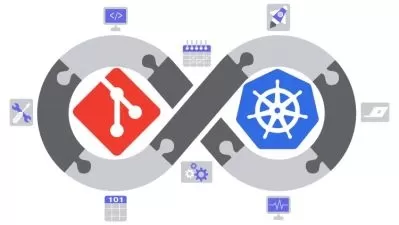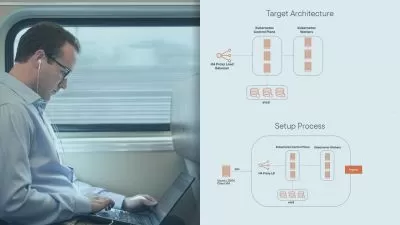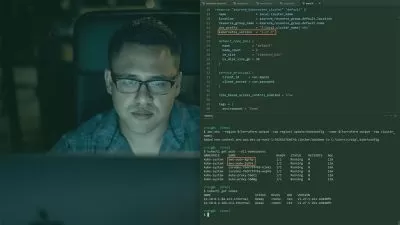Kubernetes in NFV (TelcoCloud)
Asad Khan
13:05:00
Description
Learn Kubernetes along with the contexts of NFV & TelcoCloud
What You'll Learn?
- Excellent Hands-On experience on all the Kubernetes components. Build your own lab (for free) & create K8s objects & CNFs
- Completely understand the purpose of Containerization & Cloud computing & also understand why Kubernetes is essential for mobile operators.
- Excellent understanding & decoupling of TelcoCloud components. Journey of a legacy Telco node from a proprietory machine to a VNF & then to a CNF.
- Capacity planning for cloud infrastructure, Deep dive in Kubernetes networking & storage concepts
- Amazing explanation of thoeritical concepts via analogies, real world examples & comaprative studies
Who is this for?
What You Need to Know?
More details
DescriptionFor C O U P O N S please connect with me on LinkedIn or by email. See the details in my Bio section
This course contains theory & practice for all the components of Kubernetes & that too in the context of a telco cloud i.e. in the context of NFV.
The theoretical portion contains creative diagrams, real-life examples & comparative studies so that even an absolute beginner can understand it. In this course, we will learn how to launch our own Kubernetes cluster on Google cloud for free, so that you have a lab to practice even after the completion of the course.
However, this lab is not the exact replica of a production-grade data center. Around 90% of tasks can be performed here as compared to the actual environment.
The course has been designed considering the daily job of a Telco cloud operations engineer but, anyone who is interested to understand Telco cloud or Kubernetes, in general, can benefit from this course. It contains core concepts of Kubernetes like Pods, Deployments, Services, Statefulsets, Networking, Storage, etc & how these concepts are applied in the TelcoCloud CNFs (Containerised network functions).
Course contents-
Module-1 Journey of Software deployment
Module-2 Evolution of Containers, Docker & Kubernetes
Module-3 Kubernetes Architecture
Module-4 Launching a K8s cluster on GCP
Module-5 K8s documentation & Yaml
Module-6 Kubernetes objects
Module-7 PODs
Module-8 Kubernetes connectivity - Basic principles
Module-9 Kubernetes Services
Module-10 Microservices Architecture
Module-11 Sample app deployment
Module-12 Helm
Module-13 Telco Cloud Infrastructure
Module-14 Why CNFs?
Module-15 OpenStack vs Kubernetes
Module-16 DevOps, CI/CD & Agile
Module-17 Networking in Kubernetes
Module-18 Multicontainer pods, Container logging & node interaction
Module-19 Monitoring
Module-20 Resource requests & limits
Module-21 Scheduling
Module-22 Kubernetes Storage
Module-23 Role-based access control (RBAC)
Module-24 Config Maps & secrets
Course exclusions (not included in the course) -
Data center design
Ceph Storage or any other LVM-based Storage solutions
Ingress & Egress network policies
ISTIO
Scale-out/in (addition/deletion) of a worker node
Lifecycle management (LCM) of CNFs in Kubernetes
Securing Kubernetes
Who this course is for:
- Anyone who wants to understand Kubernetes from scratch. Absolute beginner.
- Any Telecom Engineer who wants to shift his career from Legacy to Cloud - System integrators, RAN engineers, Core network, Packet core , RF , Maintenence (O&M), Transmission, Configuration, Network
- Sales people - Sales engineers, Pre-sales enginners, Solution engineers
- Managers - Project managers, Product managers, Incident & Problem managers
- Budding TelcoCloud enthusiasts who aspires to be a - Solution architect, Solution designer, Cloud engineer, Cloud integrator, etc
- Any managment executive who wants to understand Kubernetes in NFV context
For C O U P O N S please connect with me on LinkedIn or by email. See the details in my Bio section
This course contains theory & practice for all the components of Kubernetes & that too in the context of a telco cloud i.e. in the context of NFV.
The theoretical portion contains creative diagrams, real-life examples & comparative studies so that even an absolute beginner can understand it. In this course, we will learn how to launch our own Kubernetes cluster on Google cloud for free, so that you have a lab to practice even after the completion of the course.
However, this lab is not the exact replica of a production-grade data center. Around 90% of tasks can be performed here as compared to the actual environment.
The course has been designed considering the daily job of a Telco cloud operations engineer but, anyone who is interested to understand Telco cloud or Kubernetes, in general, can benefit from this course. It contains core concepts of Kubernetes like Pods, Deployments, Services, Statefulsets, Networking, Storage, etc & how these concepts are applied in the TelcoCloud CNFs (Containerised network functions).
Course contents-
Module-1 Journey of Software deployment
Module-2 Evolution of Containers, Docker & Kubernetes
Module-3 Kubernetes Architecture
Module-4 Launching a K8s cluster on GCP
Module-5 K8s documentation & Yaml
Module-6 Kubernetes objects
Module-7 PODs
Module-8 Kubernetes connectivity - Basic principles
Module-9 Kubernetes Services
Module-10 Microservices Architecture
Module-11 Sample app deployment
Module-12 Helm
Module-13 Telco Cloud Infrastructure
Module-14 Why CNFs?
Module-15 OpenStack vs Kubernetes
Module-16 DevOps, CI/CD & Agile
Module-17 Networking in Kubernetes
Module-18 Multicontainer pods, Container logging & node interaction
Module-19 Monitoring
Module-20 Resource requests & limits
Module-21 Scheduling
Module-22 Kubernetes Storage
Module-23 Role-based access control (RBAC)
Module-24 Config Maps & secrets
Course exclusions (not included in the course) -
Data center design
Ceph Storage or any other LVM-based Storage solutions
Ingress & Egress network policies
ISTIO
Scale-out/in (addition/deletion) of a worker node
Lifecycle management (LCM) of CNFs in Kubernetes
Securing Kubernetes
Who this course is for:
- Anyone who wants to understand Kubernetes from scratch. Absolute beginner.
- Any Telecom Engineer who wants to shift his career from Legacy to Cloud - System integrators, RAN engineers, Core network, Packet core , RF , Maintenence (O&M), Transmission, Configuration, Network
- Sales people - Sales engineers, Pre-sales enginners, Solution engineers
- Managers - Project managers, Product managers, Incident & Problem managers
- Budding TelcoCloud enthusiasts who aspires to be a - Solution architect, Solution designer, Cloud engineer, Cloud integrator, etc
- Any managment executive who wants to understand Kubernetes in NFV context
User Reviews
Rating
Asad Khan
Instructor's Courses
Udemy
View courses Udemy- language english
- Training sessions 102
- duration 13:05:00
- English subtitles has
- Release Date 2023/09/04















